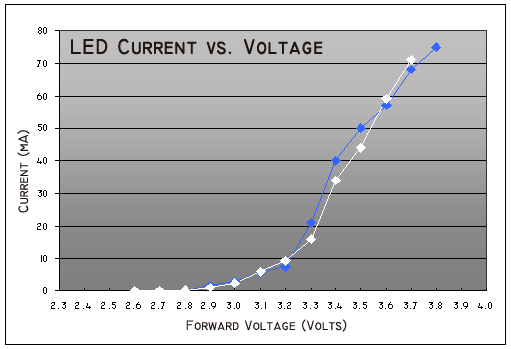Looking at the brightness of an LED and trying to guess the proper voltage is a very poor way to try to use them. First off, different LEDs have a very wide range of brightness at full rated current. If you have an unknown LED, you have no idea how bright it should be at rated current. Add to the fact that judging the actual light output by eyeball is hardly an exact science. Finally, the LED current will vary very sharply with a very small increase in voltage, so trying to control brightness that way is pretty tricky, and hazardous to the health of the LED. LED's are really current mode devices, and controlling the current is a much better way to use them as a rule.
Consider the following voltage vs. current curve for a typical white LED. Note that at 3.0 volts the current is perhaps 2 ma, but at 3.3 volts you're already at 20ma. So, for 10% of the voltage swing, you've increased the current in the LED by a factor of ten! If you increase the voltage just .2 volts more, you're running at well over twice the maximum current rating of the 20ma LED, that results in a very short life for your LED.
If someone hands me a bunch of LEDs with no data, I assume they're 20ma parts, that is by far the most common current rating. The reverse voltage rating of common LED's is in the 5-7 volt range for the most part as well.
I rarely spend a whole lot of time thinking about trying to squeeze the absolute maximum light out of an LED, I'd rather run them somewhat below their ratings, makes for a practically infinite life.
Consider that my passenger car lighting module delivers a maximum of 50ma constant current, and I typically put 24 LED's on the 12V strips in 8 groups of 3 LED's each into an 18" passenger car. If you calculate the maximum current consumed by each group, it's 6.25ma at 50ma total output of the power module. I rarely run the LED's at anything like that brightness as they are far too bright, I normally end up in the 20-25ma range to light an entire car, that's 2.5 - 3.125ma for each LED.
------------------------ How to ballpark the LED resistor -----------------------------
I take the LED working voltage, you can assume around 2 volts for red and yellow LED's, 2.5 for green, and 3.0 for white or blue. I subtract that from the RMS voltage supply, for DC that's simply the difference, for AC, that's half the voltage times 1.4. That number is multiplied by 50, and that's the minimum value of the current limiting resistor. You can make the resistor larger for less light, which I frequently do for many uses like markers, class lights, etc.
This is probably way more than you wanted to know. ![]()






